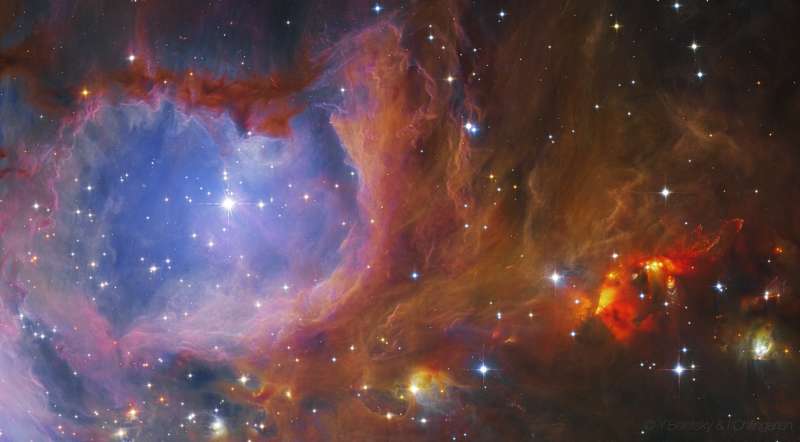Credit & Copyright: Yuri Beletsky
(Carnegie
Las Campanas Obs.),
Igor Chilingarian
(Harvard-Smithsonian CfA)
Explanation:
Often imaged
but rarely mentioned,
Messier 43
is a large star forming region in its own right.
It's just part of the star forming complex of gas and dust that
includes the larger, more famous neighboring Messier 42,
the Great Orion Nebula.
In fact,
the Great Orion Nebula itself lies off the lower edge of
this scene.
The close-up of Messier 43 was made while testing the
capabilities of a near-infrared instrument with one of the twin
6.5 meter Magellan telescopes
at Las Campanas Observatory in the Chilean Andes.
The composite image shifts the otherwise invisible infrared wavelengths
to blue, green, and red colors.
Peering into
caverns of interstellar dust hidden from
visible light, the near-infrared view can also be used
to study cool, brown dwarf stars in the complex region.
Along with its
celebrity neighbor, Messier 43 lies about
1,500 light-years away, at the edge of Orion's giant molecular cloud.
At that distance, this field of view spans about 5 light-years.
1999 2000 2001 2002 2003 2004 2005 2006 2007 2008 2009 2010 2011 2012 2013 2014 2015 2016 2017 2018 2019 2020 2021 2022 2023 2024 2025 |
Январь Февраль Март Апрель Май Июнь Июль Август Сентябрь Октябрь Ноябрь Декабрь |
NASA Web Site Statements, Warnings, and Disclaimers
NASA Official: Jay Norris. Specific rights apply.
A service of: LHEA at NASA / GSFC
& Michigan Tech. U.
|
Публикации с ключевыми словами:
star formation - infrared - Молекулярные облака - звездообразование - инфракрасные наблюдения - инфракрасное излучение
Публикации со словами: star formation - infrared - Молекулярные облака - звездообразование - инфракрасные наблюдения - инфракрасное излучение | |
См. также:
Все публикации на ту же тему >> | |
